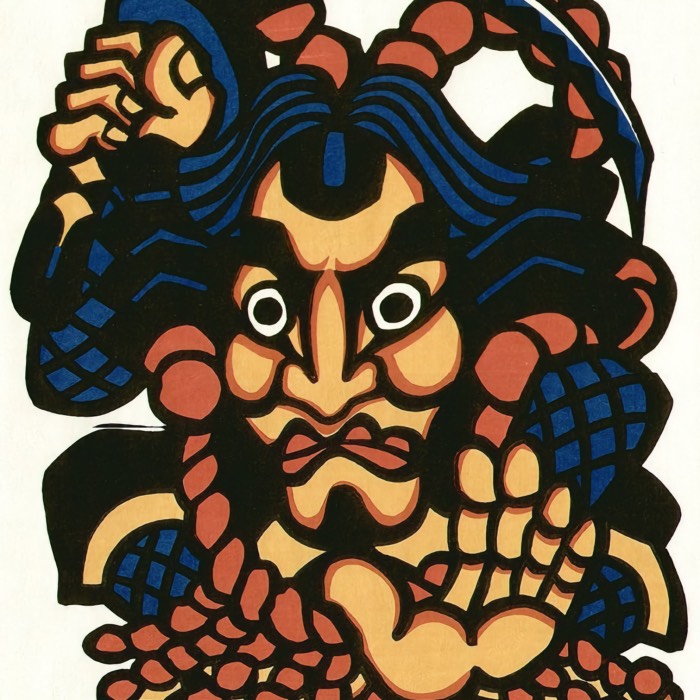Hashiguchi Goyō: Pioneer of Shin Hanga
Hashiguchi Goyō (1880-1921) was a pioneering artist of Shin Hanga. He is best known for his exquisite bijin-ga (paintings of beautiful women), which are celebrated for their elegance and attention to detail. Goyō’s work represents a fusion of traditional ukiyo-e aesthetics and modern Western techniques, creating a unique style within the Shin Hanga movement. Here is a short dossier on him along with some of his most famous prints.
 Kamisuki (Combing the hair), Goyō Hashiguchi, 1920. Source: Wikimedia Commonsꜛ (license: public domain)
Kamisuki (Combing the hair), Goyō Hashiguchi, 1920. Source: Wikimedia Commonsꜛ (license: public domain)
Biography
Hashiguchi Goyō (橋口 五葉) was born on December 21, 1880, in Kagoshima, Japan, into a family with strong artistic roots. His father, Hashiguchi Kanemitsu, was an amateur painter, and Goyō grew up in an environment that nurtured his artistic talents. The influence of his father and his early exposure to art deeply shaped his future career.

Photograph of Kiyoshi Hashiguchi, 1880. Source: Wikimedia Commonsꜛ (license: public domain)
Goyō moved to Tokyo in 1899 to study Western painting at the Tokyo School of Fine Arts under the guidance of Kuroda Seiki, one of the most prominent Japanese artists who had studied in France and brought back the techniques of Western realism and Impressionism. Goyō’s education in Western painting techniques and his exposure to European art styles had a profound impact on his artistic development.
After graduating in 1905, Goyō initially worked as a painter and illustrator, contributing to various publications and honing his skills in a wide range of artistic styles. However, his true calling emerged when he turned his attention to ukiyo-e and woodblock printing, particularly the genre of bijin-ga (pictures of beautiful women). Goyō was deeply influenced by the works of Kitagawa Utamaro and Toshusai Sharaku, two of the most famous ukiyo-e artists, whose portrayals of women and kabuki actors left a lasting impression on him.
In 1911, Goyō began collaborating with Watanabe Shōzaburō, a visionary publisher who was spearheading the Shin Hanga movement. This collaboration marked the beginning of Goyō’s involvement in woodblock printing, and it was during this period that he produced some of his most famous works. Despite his late entry into the field of woodblock printing, Goyō quickly established himself as one of the leading artists of the Shin Hanga movement.
Goyō’s career, however, was tragically short-lived. He suffered from chronic health problems and died prematurely from meningitis on February 24, 1921, at the age of 40. Despite his brief career, Goyō left behind a legacy as one of the most important and influential artists of the Shin Hanga movement, particularly in the genre of bijin-ga.
Artistic style and significance
Hashiguchi Goyō is best known for his exquisite bijin-ga prints, which are celebrated for their elegance, grace, and meticulous detail. His work is characterized by a synthesis of traditional ukiyo-e aesthetics and modern Western techniques, making him a pivotal figure in the Shin Hanga movement.
Fusion of Eastern and Western techniques
Goyō’s education in Western painting deeply influenced his approach to woodblock printing. He integrated elements of Western realism, such as the use of light and shadow, into the traditional ukiyo-e framework. This blend of styles allowed Goyō to create prints that were both strikingly modern and deeply rooted in Japanese tradition.


A touch of Art Nouveau: Left: February 1905 Hototogisu, Goyō Hashiguchi, 1905. Source: Wikimedia Commonsꜛ (license: public domain) – Right: March 1905 Hototogisu, Goyō Hashiguchi, 1905. Source: Wikimedia Commonsꜛ (license: public domain)
Goyō’s bijin-ga are distinguished by their delicate rendering of feminine beauty. His attention to detail is evident in the intricate patterns of the women’s kimonos, the subtle expressions on their faces, and the careful depiction of their hairstyles. Goyō’s prints capture the essence of feminine grace and poise, often portraying women in intimate, contemplative moments.
 A Woman Applying Makeup, Goyō Hashiguchi, 1918. Source: Wikimedia Commonsꜛ (license: public domain)
A Woman Applying Makeup, Goyō Hashiguchi, 1918. Source: Wikimedia Commonsꜛ (license: public domain)
Mastery of bijin-ga
Goyō’s bijin-ga prints are considered some of the finest examples of this genre in the Shin Hanga movement. His ability to convey the subtle nuances of beauty, emotion, and personality in his portraits of women set a new standard for bijin-ga. Unlike the more stylized and idealized portrayals of women in traditional ukiyo-e, Goyō’s women are depicted with a greater sense of individuality and realism.
Goyō’s work also reflects a deep respect for the traditional ukiyo-e masters, particularly Kitagawa Utamaro, whose influence is evident in Goyō’s compositions and subject matter. However, Goyō brought a modern sensibility to his work, incorporating the naturalistic techniques he had learned from Western art into the rich visual language of ukiyo-e.
Impact and legacy
Although his career was brief, Hashiguchi Goyō left an indelible mark on the Shin Hanga movement. His prints are highly sought after by collectors and are considered masterpieces of modern Japanese art. Goyō’s work helped to revive interest in ukiyo-e and ensured that the genre of bijin-ga remained a central focus of Japanese woodblock printing in the 20th century.
Goyō’s influence extended beyond his own time, inspiring future generations of artists in Japan and abroad. His ability to seamlessly blend traditional and modern techniques has made him a key figure in the history of Japanese art, and his prints continue to be celebrated for their beauty, craftsmanship, and emotional depth.

In 1984, Stephe Jobs used a Shin Hanga print, A Woman Combing Her Hair, to demonstrate the graphical capabilities of the new Macintosh computer then presented. Source: Wikimedia Commonsꜛ (license: public domain)
Notable works
Despite his short career, Hashiguchi Goyō produced a number of significant works that are considered landmarks of the Shin Hanga movement. Here are some of his most notable prints:
 Onsen yado (Hotspring Hotel), Goyō Hashiguchi, 1920. Source: Wikimedia Commonsꜛ (license: public domain)
Onsen yado (Hotspring Hotel), Goyō Hashiguchi, 1920. Source: Wikimedia Commonsꜛ (license: public domain)
 Yokugo no onna, Goyō Hashiguchi, 1915. Source: Wikimedia Commonsꜛ (license: public domain)
Yokugo no onna, Goyō Hashiguchi, 1915. Source: Wikimedia Commonsꜛ (license: public domain)
 Woman in summer clothing, Goyō Hashiguchi, 1920. Source: Wikimedia Commonsꜛ (license: public domain)
Woman in summer clothing, Goyō Hashiguchi, 1920. Source: Wikimedia Commonsꜛ (license: public domain)
 Woman After Bath, Goyō Hashiguchi, 1920. Source: Wikimedia Commonsꜛ (license: public domain)
Woman After Bath, Goyō Hashiguchi, 1920. Source: Wikimedia Commonsꜛ (license: public domain)
 Woman folding kimono, Goyō Hashiguchi, 1920. Source: Wikimedia Commonsꜛ (license: public domain)
Woman folding kimono, Goyō Hashiguchi, 1920. Source: Wikimedia Commonsꜛ (license: public domain)
 Rain at Yabakei, Goyō Hashiguchi, 1918. Source: Wikimedia Commonsꜛ (license: public domain)
Rain at Yabakei, Goyō Hashiguchi, 1918. Source: Wikimedia Commonsꜛ (license: public domain)
 Geisha Hisae with a Towel, Goyō Hashiguchi, 1920. Source: Wikimedia Commonsꜛ (license: public domain)
Geisha Hisae with a Towel, Goyō Hashiguchi, 1920. Source: Wikimedia Commonsꜛ (license: public domain)
 Girl in Summer Costume (Natsu yosooi no musume), Goyō Hashiguchi, 1920. Source: Wikimedia Commonsꜛ (license: public domain)
Girl in Summer Costume (Natsu yosooi no musume), Goyō Hashiguchi, 1920. Source: Wikimedia Commonsꜛ (license: public domain)
 Evening Moon at Kobe, Goyō Hashiguchi. Source: Wikimedia Commonsꜛ (license: public domain)
Evening Moon at Kobe, Goyō Hashiguchi. Source: Wikimedia Commonsꜛ (license: public domain)
 Mt. Ibuki in snow, Goyō Hashiguchi, 1920. Source: Wikimedia Commonsꜛ (license: public domain)
Mt. Ibuki in snow, Goyō Hashiguchi, 1920. Source: Wikimedia Commonsꜛ (license: public domain)
 Sanjo Bridge, Kyoto, Goyō Hashiguchi. Source: Wikimedia Commonsꜛ (license: public domain)
Sanjo Bridge, Kyoto, Goyō Hashiguchi. Source: Wikimedia Commonsꜛ (license: public domain)
 Postcard of a woman sniffing a flower, Goyō Hashiguchi. Source: Wikimedia Commonsꜛ (license: public domain)
Postcard of a woman sniffing a flower, Goyō Hashiguchi. Source: Wikimedia Commonsꜛ (license: public domain)
 Woman in a Tree Grove, Goyō Hashiguchi. Source: Wikimedia Commonsꜛ (license: public domain)
Woman in a Tree Grove, Goyō Hashiguchi. Source: Wikimedia Commonsꜛ (license: public domain)
 Woman Washing Her Face, Goyō Hashiguchi, 1920. Source: Wikimedia Commonsꜛ (license: public domain)
Woman Washing Her Face, Goyō Hashiguchi, 1920. Source: Wikimedia Commonsꜛ (license: public domain)
 Woman Applying Color to Her Lips, Goyō Hashiguchi. Source: Wikimedia Commonsꜛ (license: public domain)
Woman Applying Color to Her Lips, Goyō Hashiguchi. Source: Wikimedia Commonsꜛ (license: public domain)
 Waitress with a Red Tray, Goyō Hashiguchi. Source: Wikimedia Commonsꜛ (license: public domain)
Waitress with a Red Tray, Goyō Hashiguchi. Source: Wikimedia Commonsꜛ (license: public domain)
 Two Ducks, Goyō Hashiguchi. Source: Wikimedia Commonsꜛ (license: public domain)
Two Ducks, Goyō Hashiguchi. Source: Wikimedia Commonsꜛ (license: public domain)
Conclusion
Hashiguchi Goyō is remembered as one of the most significant artists of the Shin Hanga movement, particularly for his contributions to the genre of bijin-ga. His prints, which seamlessly blend traditional ukiyo-e aesthetics with modern Western techniques, remain celebrated for their beauty, craftsmanship, and emotional depth. Goyō’s ability to capture the delicate nuances of feminine beauty has earned him a lasting place in the history of Japanese art, and his work continues to inspire and captivate audiences around the world.
References and further reading
- Chris Uhlenbeck, Jim Dwinger, Philo Ouweleen, Shin Hanga - Die »Neuen Drucke« Japans 1900-1950, 2022, Hatje Cantz, ISBN: 9783775752190
- viewingjapaneseprints.netꜛ
- Hashiguchi Goyō on ukiyo-e.orgꜛ











comments